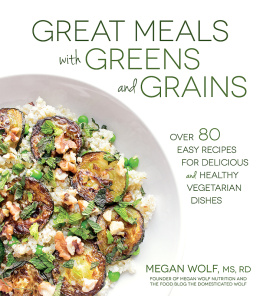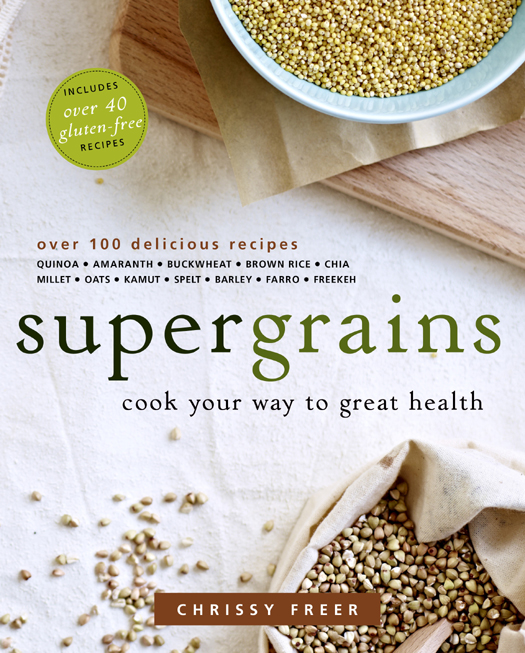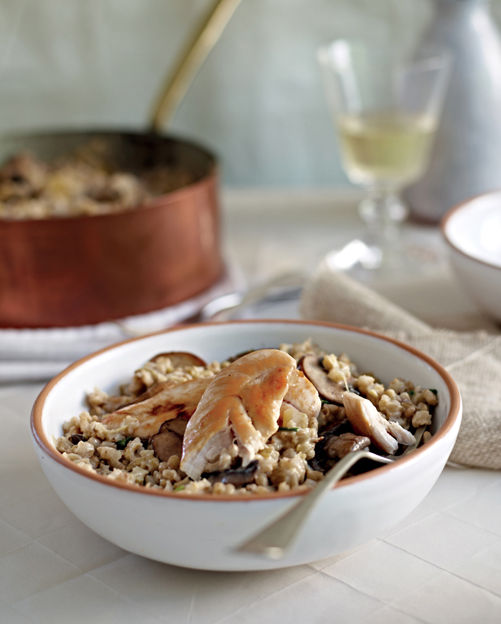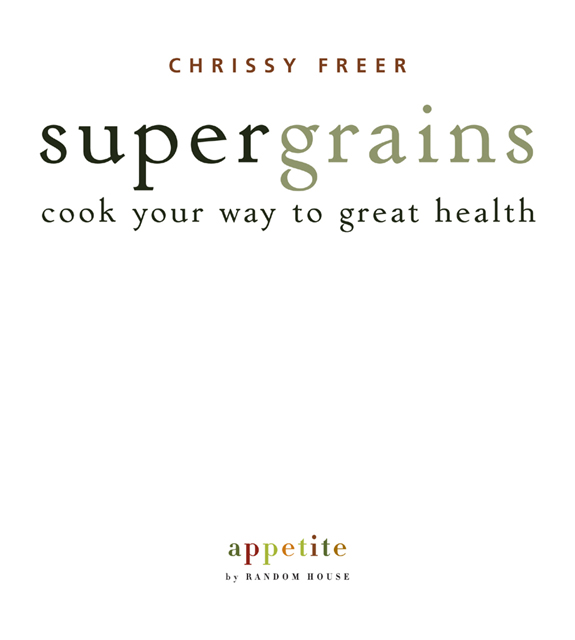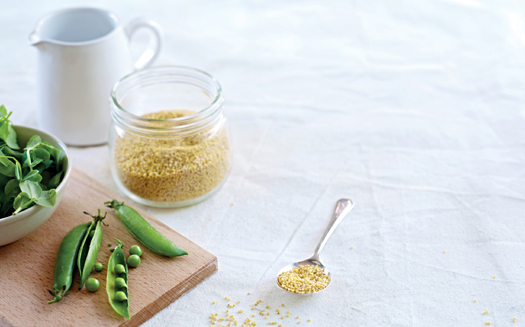Whole grain suppliers
Eden Organic
www.edenfoods.com
Bobs Red Mill
www.bobsredmill.com
Bluebird Grain Farms
www.bluebirdgrainfarms.com
Text 2013 Murdoch Books Pty Limited
Design 2013 Murdoch Books Pty Limited
Photography 2013 Murdoch Books Pty Limited
Cover photography by Julie Renouf
All rights reserved. The use of any part of this publication, reproduced, transmitted in any form or by any means electronic, mechanical, photocopying, recording or otherwise, or stored in a retrieval system without the prior written consent of the publisheror in the case of photocopying or other reprographic copying, license from the Canadian Copyright Licensing Agencyis an infringement of the copyright law.
Appetite by Random House and colophon are registered trademarks
Library and Archives of Canada Cataloguing in Publication is available upon request
eISBN: 978-0-449-01572-8
Recipes, text and styling: Chrissy Freer
Designer: Susanne Geppert
Photographer: Julie Renouf
Project Editor: Martina Vascotto
Editor: Anna Scobie
Food Editor: Christine Osmond
Home Economist: Caroline Griffiths
Production: Karen Small
The Publisher and stylist would like to thank Breville, Country Road, Est Australia, Market Import, Mozi, Mud Australia, Royal Hamam, Status Collections, The Works Bed Bath N Table and Urban Edge Ceramics for lending equipment and props for use and photography.
IMPORTANT: Those who might be at risk from the effects of salmonella poisoning (the elderly, pregnant women, young children and those suffering from immune deficiency diseases) should consult their doctor with any concerns about eating raw eggs.
OVEN GUIDE: You may find cooking times vary depending on the oven you are using. For convection ovens, as a general rule, set the oven temperature to 35F (20C) lower than indicated in the recipe.
Published in Canada by Appetite by Random House,
a division of Random House of Canada Limited
www.randomhouse.ca
v3.1
Contents
Introduction
grains?
In todays society, the impact food can have on our health is becoming increasingly important. A superfood is a food that by nature is nutrient dense compared to its energy value. Supergrains are grains that are not only packed with nutrients, but have also been linked to many health benefits, which is why they are currently gaining worldwide interest.
Lets start by defining grains. These are the seeds of certain plants, where the hard inedible husk or outer layer is removed, leaving the edible grain (or berry). Unrefined (whole) grains contain all three parts of the grain: the bran, germ and endosperm. Supergrains (in their simplest forms) are all unrefined grains. Refined grains have the bran and germ removed, leaving just the endosperm which contains the least vitamins and minerals.
This book explores 12 supergrains: kamut, barley, farro and freekeh. We look at their history, nutritive and health benefits, what they are best used for and how to cook them. There are delicious recipes for each supergrain so you will have the confidence to incorporate them into your everyday life.
Although some of the supergrains are quite common, others you may not have heard of, despite the fact that they have been around for centuries. Spelt, for instance, was a staple grain in ancient civilizations such as Greece and Rome. One of the main reasons for their decline in popularity was the modernization of farming methods, which produced more refined, highly processed foods. Compared to these new, refined foods, supergrains came to be considered by many cultures as peasant food, only eaten by the very poor or even fed to the animals.
The problem with replacing supergrains with refined grains, however, is that the latter are much lower in nutrients, healthy fats, antioxidants and phytonutrients. Although most of the grains currently consumed in first-world countries are highly refined, such as white rice, white wheat flour and ground cornmeal, there is renewed interest in supergrains for their health benefits, superior taste and suitability for restricted diets, such as gluten and wheat intolerances, vegetarians and vegans.
Another reason for the re-emergence of supergrains is a growing interest in making food more simplistic, by going back to its original source and subjecting it to minimal refining. Farmers markets, the organic and biodynamic food movements, the demand for quality ingredients and the move towards whole foods all indicate an increasing awareness and interest in what goes into food products and their natural health benefits.
As supergrains gain in popularity, their availability also improves. Quinoa, for example, was once considered a speciality grain, only found in serious health food stores and on restaurant menus, but today it can be found in almost every major supermarket. Kamut and spelt are enjoying a renewed popularity, too, especially in the form of baked products such as bread. Chia is also receiving a lot of attention as it contains more omega 3 and dietary fiber than any other natural food.
The recipes in this book reflect my approach to health and eating everything in moderation, with a focus on whole foods, such as supergrains. Eating responsible portion sizes means that occasional treats can be enjoyed (and, in fact, are a must!). Meals should be balanced, with one portion of protein, one portion of complex carbohydrates and two to three servings of vegetables. I hope these delicious recipes inspire you and contribute to your own healthy eating.
Health benefits
Controlling blood sugar levels
The diabetes.
High fiber
Supergrains are an excellent source of dietary fiber, whether soluble, insoluble or both. Soluble fiber is water soluble, as the name suggests, and forms a thick gel-like substance. This gel helps keep the bowel healthy, reduces blood cholesterol and slows the release of sugars in the blood, which is very useful for those with diabetes. Insoluble fiber, on the other hand, stays intact even when in contact with water. Insoluble fiber helps in preventing constipation and irritable bowel syndrome, keeps your colon healthy and assists with heart health.
Reduced risk of obesity/weight management
Studies are beginning to show that supergrains can play an important role in reducing the risk of obesity when they are used as a tool for weight control. They are higher in fiber than highly processed grains, especially soluble fiber which can increase satiety so you feel full for longer and therefore eat less overall.
Prebiotic effect
Prebiotics are foods that stimulate the growth of healthy bacteria, helping to produce digestive enzymes. There have been recent studies on the prebiotic effects that supergrains can have in the digestive system, mainly due to the fermentation of the soluble fibre they contain.











